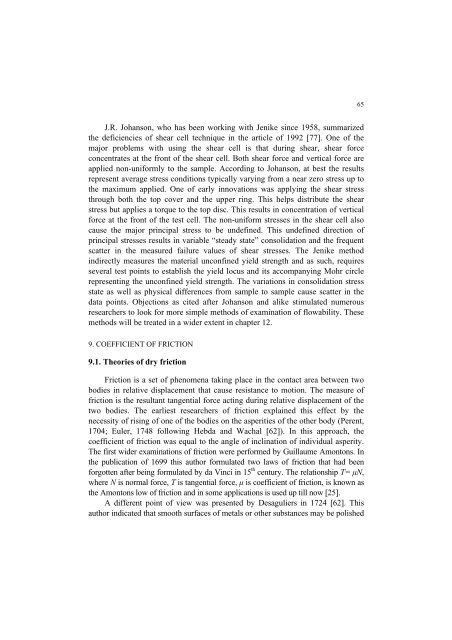Strona 2_redak - Instytut Agrofizyki im. Bohdana DobrzaÅskiego ...
Strona 2_redak - Instytut Agrofizyki im. Bohdana DobrzaÅskiego ...
Strona 2_redak - Instytut Agrofizyki im. Bohdana DobrzaÅskiego ...
You also want an ePaper? Increase the reach of your titles
YUMPU automatically turns print PDFs into web optimized ePapers that Google loves.
65<br />
J.R. Johanson, who has been working with Jenike since 1958, summarized<br />
the deficiencies of shear cell technique in the article of 1992 [77]. One of the<br />
major problems with using the shear cell is that during shear, shear force<br />
concentrates at the front of the shear cell. Both shear force and vertical force are<br />
applied non-uniformly to the sample. According to Johanson, at best the results<br />
represent average stress conditions typically varying from a near zero stress up to<br />
the max<strong>im</strong>um applied. One of early innovations was applying the shear stress<br />
through both the top cover and the upper ring. This helps distribute the shear<br />
stress but applies a torque to the top disc. This results in concentration of vertical<br />
force at the front of the test cell. The non-uniform stresses in the shear cell also<br />
cause the major principal stress to be undefined. This undefined direction of<br />
principal stresses results in variable “steady state” consolidation and the frequent<br />
scatter in the measured failure values of shear stresses. The Jenike method<br />
indirectly measures the material unconfined yield strength and as such, requires<br />
several test points to establish the yield locus and its accompanying Mohr circle<br />
representing the unconfined yield strength. The variations in consolidation stress<br />
state as well as physical differences from sample to sample cause scatter in the<br />
data points. Objections as cited after Johanson and alike st<strong>im</strong>ulated numerous<br />
researchers to look for more s<strong>im</strong>ple methods of examination of flowability. These<br />
methods will be treated in a wider extent in chapter 12.<br />
9. COEFFICIENT OF FRICTION<br />
9.1. Theories of dry friction<br />
Friction is a set of phenomena taking place in the contact area between two<br />
bodies in relative displacement that cause resistance to motion. The measure of<br />
friction is the resultant tangential force acting during relative displacement of the<br />
two bodies. The earliest researchers of friction explained this effect by the<br />
necessity of rising of one of the bodies on the asperities of the other body (Perent,<br />
1704; Euler, 1748 following Hebda and Wachal [62]). In this approach, the<br />
coefficient of friction was equal to the angle of inclination of individual asperity.<br />
The first wider examinations of friction were performed by Guillaume Amontons. In<br />
the publication of 1699 this author formulated two laws of friction that had been<br />
forgotten after being formulated by da Vinci in 15 th century. The relationship 7 1,<br />
where N is normal force, T is tangential force, is coefficient of friction, is known as<br />
the Amontons low of friction and in some applications is used up till now [25].<br />
A different point of view was presented by Desaguliers in 1724 [62]. This<br />
author indicated that smooth surfaces of metals or other substances may be polished
















